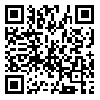Volume 75, Issue 8 (November 2017)
Tehran Univ Med J 2017, 75(8): 570-576 |
Back to browse issues page
Download citation:
BibTeX | RIS | EndNote | Medlars | ProCite | Reference Manager | RefWorks
Send citation to:



BibTeX | RIS | EndNote | Medlars | ProCite | Reference Manager | RefWorks
Send citation to:
Behnamfar F, Jafari M, Moslehi M. Sentinel lymph node mapping using methylene blue and Technetium-99 in early endometrial cancer. Tehran Univ Med J 2017; 75 (8) :570-576
URL: http://tumj.tums.ac.ir/article-1-8388-en.html
URL: http://tumj.tums.ac.ir/article-1-8388-en.html
1- Department of Obstetrics and Gynecology, School of Medicine, Isfahan University of Medical Sciences, Isfahan, Iran. , f_behnamfar@yahoo.com
2- Department of Obstetrics and Gynecology, School of Medicine, Isfahan University of Medical Sciences, Isfahan, Iran.
3- Department of Nuclear Medicine, Isfahan University of Medical Sciences, Isfahan, Iran.
2- Department of Obstetrics and Gynecology, School of Medicine, Isfahan University of Medical Sciences, Isfahan, Iran.
3- Department of Nuclear Medicine, Isfahan University of Medical Sciences, Isfahan, Iran.
Abstract: (3416 Views)
Background: Endometrial cancer (EC) is the most prevalent genital related cancer of females. One of the controversial points about endometrial cancer surgery is preserving or dissection of sentinel lymph nodes (SLNs). Lymphatic mapping and sentinel nodes sample has been used widely for diverse solid tumors in order of finding metastasis in lymph nodes. The aim of current study was to evaluate diagnostic value of technetium-99 and methylene blue in diagnosis of sentinel lymph node involvement in low-risk endometrial cancer.
Methods: This cross-sectional study was conducted through 2016 on 14 patients with low-grade endometrial cancer referred to Al-Zahra and Shahid Beheshti Hospitals (affiliated to Isfahan University of Medical Sciences), Iran, in 2016-17. Eighteen and twenty-four hours before operation, patients underwent technetium-99 (Tc-99) injection to uterine cervix. Twenty-four hours prior to surgery, patients were referred to resident of gynecology and filled demographic checklist. In next day during operation, Tc-99 was detected by gamma probe. Methylene blue was injected in operation room and blue nodes were detected by naked eye. All patients underwent total hysterectomy, bilateral salpingo-oophorectomy and pelvic lymphadenectomy. Dissected lymph nodes were sent for frozen section and assessment of positive/negative metastasis. Then data were analyzed with SPSS software, version 20 (SPSS Inc., Chicago, IL, USA).
Results: Mean age of our patients was 60.64±9.18 years. Total number of 80 SLNs was dissected. 18.8% of nodes were detected using methylene blue, 12.5% using tecnethium-99 and 6.3% were in common with both methods. Number of two nodes was metastatic and was detected by blue dye and Tc-99. Sensitivity, negative predictive value and detection rate of Tc-99 alone, methylene blue alone and their combination was 100% and false negativity of all above was 100%.
Conclusion: Due to findings of our study, as sensitivity, detection rate, negative predictive value and false negativity of methods lonely and in combination were similar thus based on higher probability of blue dye adverse effects, use of Tc-99 lonely may be adequate.
Methods: This cross-sectional study was conducted through 2016 on 14 patients with low-grade endometrial cancer referred to Al-Zahra and Shahid Beheshti Hospitals (affiliated to Isfahan University of Medical Sciences), Iran, in 2016-17. Eighteen and twenty-four hours before operation, patients underwent technetium-99 (Tc-99) injection to uterine cervix. Twenty-four hours prior to surgery, patients were referred to resident of gynecology and filled demographic checklist. In next day during operation, Tc-99 was detected by gamma probe. Methylene blue was injected in operation room and blue nodes were detected by naked eye. All patients underwent total hysterectomy, bilateral salpingo-oophorectomy and pelvic lymphadenectomy. Dissected lymph nodes were sent for frozen section and assessment of positive/negative metastasis. Then data were analyzed with SPSS software, version 20 (SPSS Inc., Chicago, IL, USA).
Results: Mean age of our patients was 60.64±9.18 years. Total number of 80 SLNs was dissected. 18.8% of nodes were detected using methylene blue, 12.5% using tecnethium-99 and 6.3% were in common with both methods. Number of two nodes was metastatic and was detected by blue dye and Tc-99. Sensitivity, negative predictive value and detection rate of Tc-99 alone, methylene blue alone and their combination was 100% and false negativity of all above was 100%.
Conclusion: Due to findings of our study, as sensitivity, detection rate, negative predictive value and false negativity of methods lonely and in combination were similar thus based on higher probability of blue dye adverse effects, use of Tc-99 lonely may be adequate.
Type of Study: Original Article |
Send email to the article author
| Rights and permissions | |
 |
This work is licensed under a Creative Commons Attribution-NonCommercial 4.0 International License. |





